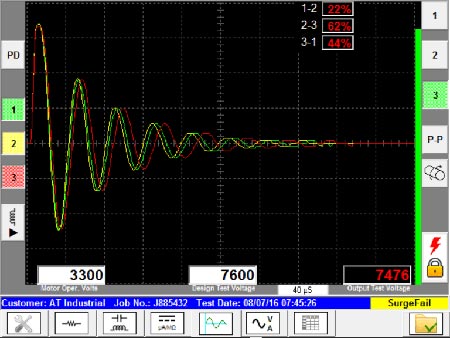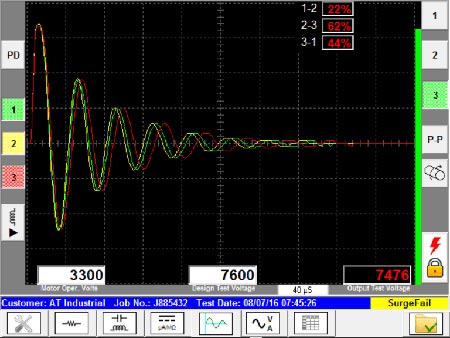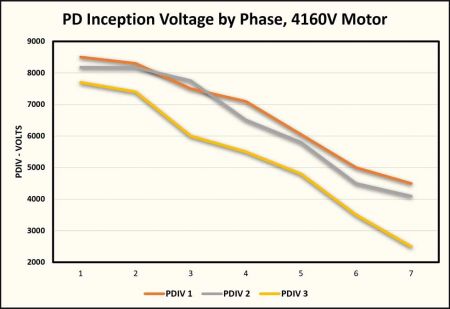
Many motor maintenance and reliability programs focus on online testing methods. In other words, while the motor is running, its temperature, vibration, current and other conditions are continuously monitored.
Real-time data and alerts can be generated. This is critical information for many large pump motors, but it is not the only source. Offline testing provides valuable data that can be incorporated into users’ maintenance and reliability program.
Offline Testing
Sometimes called static motor testing, offline testing can find insulation weaknesses by testing above operating voltages.
This provides earlier warning of issues and insulation problems than measurements taken at operating voltage and enables the owner to keep running the motor while planning what to do.
When test voltages exceed the peak operating voltage of the motor, it is known as overvoltage testing and is the key for finding insulation breakdown early. Overvoltage testing includes the surge test, partial discharge (PD) measurement and direct current (DC) high-potential (hipot) test.

A surge test is one of the most common motor tests and can find turn-to-turn insulation weakness in a motor’s windings. If undetected, turn-to-turn insulation weaknesses will first cause turn-to-turn shorts, then ground wall insulation breakdown, which causes catastrophic motor failures. During a surge test, voltage impulses are applied to a winding. This results in decaying waves in each motor phase and are recorded and displayed by a tester.
If turn-to-turn insulation damage is present, a wave frequency difference occurs between the phases or coils being tested.
The difference is calculated as a percent, and failure limits for the percentage difference can be set (Image 1).
DC hipot tests provide important information about breakdown of the ground wall insulation. DC hipot tests include both step voltage and ramp tests that indicate at which voltage the ground wall insulation starts to break down if there are weaknesses.
Predictive Maintenance
A surge test or hipot test failure above operating voltage means that the motor should be scheduled for recondition or replacement, but it does not have to be taken out immediately. A DC hipot or surge test failure is not damaging to the windings if the tests are done according to instructions and standards.

The PD measurement provides the earliest indicator of insulation breakdown. It’s best used as a predictive maintenance tool to trend measurements over time. If the voltage at which PD is first detected—known as the repetitive PD inception voltage (RPDIV)— declines over a period of time, this may indicate insulation breakdown (Image 2).
Motor Data
Testing motors generates a large amount of data, so data storage and analytics is an important part of the job. Some facilities have hundreds, if not thousands, of motors under management. In addition to the test results, asset managers need a tester that can import and store motor data such as motor ID number, asset number, location/description and other motor specifications.
Reporting
Advanced static testers generate reports and allow users to view test summaries in standard reporting software. With Excel or other spreadsheet and database software, trend analysis shows gradual changes in insulation systems and helps users identify issues before it is too late. Additionally, comparison of groups of motors with similar specifications is possible so “bad apples” stand out and can be addressed.
Portability
Not all motors can be tested from a central location. Advanced static motor testers are portable and have a rugged, self-contained case. They are built for testing a wide range of motors in facility or field applications. For higher voltages, portability becomes more critical. Power packs are available that are controlled by the tester and can boost testing voltages up to 40 kilovolt (kV).
Wide Range of Tests
Depending on the types and motors in use, testing voltages can range greatly. Alternating current (AC) motors, DC
motors, generators and a selection of transformers can be tested offline. In addition to the overvoltage tests mentioned above, static motor testing can also include low voltage tests to give a more complete picture of a motor’s insulation health.
Other tests include:
- insulation resistance: egohm, dielectric absorption ratio (DAR), polarization index (PI)
- winding resistance measurements
- capacitance, inductance, impedance and phase angle measurements
- rotor influence check (RIC) test to find squirrel cage rotor issues
Test From the MCC
For facilities with a motor control center (MCC), motors can be tested directly through the power cables from a remote location. There are several caveats, however.

Power to the motor must be shut down and the power source disconnected. The tests and measurements performed will include the motor, the power cable and any connections/junctions. Components connected to the power cable or to the incoming power in the motor may have to be disconnected or shorted out depending on the voltage they can handle and the voltage one wants to test to. These components include current transformers, surge arrestors, power factor capacitors
and filters.
The power cable from the MCC to the motor adds capacitance to the surge test circuit. The longer the cable, the higher the capacitance. The higher the total capacitance (including the motor capacitance), the more energy is required to reach the desired test voltage. Some resistance and inductance is also added by the cable. This means that some voltage is dropped across the cable and the actual test voltage in the motor is less than what is displayed by the tester. If the voltage required cannot be reached, the motor may need to be tested directly at the motor junction box. Alternatively, a tester with a higher output voltage or a power pack may be needed.
If a test failure occurs, it could be a failure in the motor windings, the power cable or a junction. To find out which, the motor must be tested directly at the motor junction box.
What Tests Are Possible From the MCC?
Tests typically include winding resistance, megohm/PI, DC hipot and surge tests. PD tests are typically not useful from the MCC because PD spikes attenuate as they travel through the power cable. Furthermore, there can be PD in the cable and in any cable junction in the circuit.
Therefore, PD tests should be done directly on the motor junction box. High voltage DC hipot tests from the MCC are not recommended by some because there is concern it could cause treeing in the cables. If this is a concern, the DC hipot voltage can be reduced, or a ramp test used instead of a step voltage test.
Static motor testing arms asset managers with additional information to keep their pumps running. To prevent unplanned downtime and assist with reliability and predictive maintenance programs, asset managers use static motor testers to find cases of weak insulation sooner than online testing can.

